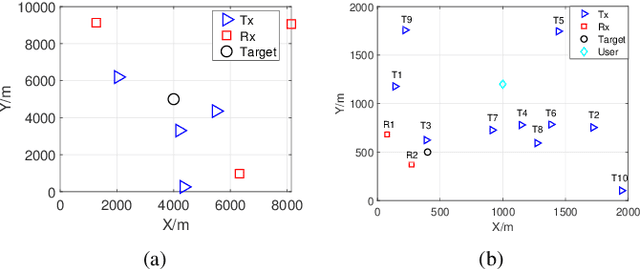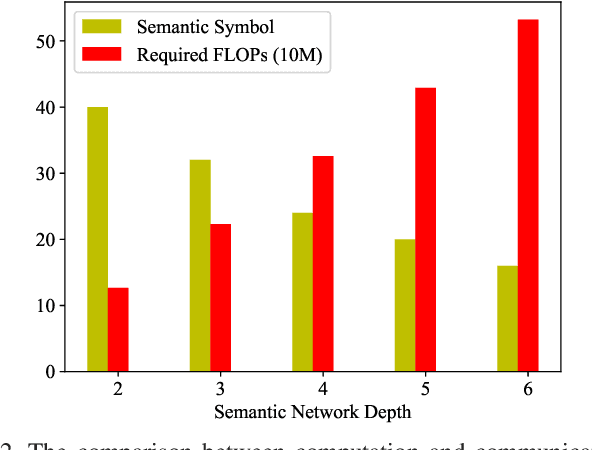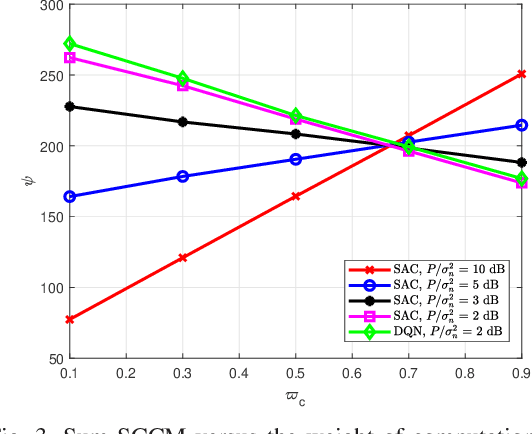Pei Xiao
A Secure Affine Frequency Division Multiplexing for Wireless Communication Systems
Oct 02, 2025Abstract:Affine frequency division multiplexing (AFDM) has garnered significant attention due to its superior performance in high-mobility scenarios, coupled with multiple waveform parameters that provide greater degrees of freedom for system design. This paper introduces a novel secure affine frequency division multiplexing (SE-AFDM) system, which advances prior designs by dynamically varying an AFDM pre-chirp parameter to enhance physical-layer security. In the SE-AFDM system, the pre-chirp parameter is dynamically generated from a codebook controlled by a long-period pseudo-noise (LPPN) sequence. Instead of applying spreading in the data domain, our parameter-domain spreading approach provides additional security while maintaining reliability and high spectrum efficiency. We also propose a synchronization framework to solve the problem of reliably and rapidly synchronizing the time-varying parameter in fast time-varying channels. The theoretical derivations prove that unsynchronized eavesdroppers cannot eliminate the nonlinear impact of the time-varying parameter and further provide useful guidance for codebook design. Simulation results demonstrate the security advantages of the proposed SE-AFDM system in high-mobility scenarios, while our hardware prototype validates the effectiveness of the proposed synchronization framework.
A Survey on Parallel Text Generation: From Parallel Decoding to Diffusion Language Models
Aug 12, 2025Abstract:As text generation has become a core capability of modern Large Language Models (LLMs), it underpins a wide range of downstream applications. However, most existing LLMs rely on autoregressive (AR) generation, producing one token at a time based on previously generated context-resulting in limited generation speed due to the inherently sequential nature of the process. To address this challenge, an increasing number of researchers have begun exploring parallel text generation-a broad class of techniques aimed at breaking the token-by-token generation bottleneck and improving inference efficiency. Despite growing interest, there remains a lack of comprehensive analysis on what specific techniques constitute parallel text generation and how they improve inference performance. To bridge this gap, we present a systematic survey of parallel text generation methods. We categorize existing approaches into AR-based and Non-AR-based paradigms, and provide a detailed examination of the core techniques within each category. Following this taxonomy, we assess their theoretical trade-offs in terms of speed, quality, and efficiency, and examine their potential for combination and comparison with alternative acceleration strategies. Finally, based on our findings, we highlight recent advancements, identify open challenges, and outline promising directions for future research in parallel text generation.
Joint Beamforming and Position Optimization for Fluid STAR-RIS-NOMA Assisted Wireless Communication Systems
Jul 09, 2025Abstract:To address the limitations of traditional reconfigurable intelligent surfaces (RIS) in spatial control capability, this paper introduces the concept of the fluid antenna system (FAS) and proposes a fluid simultaneously transmitting and reflecting RIS (FSTAR-RIS) assisted non-orthogonal multiple access (NOMA) multi-user communication system. In this system, each FSTAR-RIS element is capable of flexible mobility and can dynamically adjust its position in response to environmental variations, thereby enabling simultaneous service to users in both the transmission and reflection zones. This significantly enhances the system's spatial degrees of freedom (DoF) and service adaptability. To maximize the system's weighted sum-rate, we formulate a non-convex optimization problem that jointly optimizes the base station beamforming, the transmission/reflection coefficients of the FSTAR-RIS, and the element positions. An alternating optimization (AO) algorithm is developed, incorporating successive convex approximation (SCA), semi-definite relaxation (SDR), and majorization-minimization (MM) techniques. In particular, to address the complex channel coupling introduced by the coexistence of direct and FSTAR-RIS paths, the MM framework is employed in the element position optimization subproblem, enabling an efficient iterative solution strategy. Simulation results validate that the proposed system achieves up to a 27% increase in total sum rate compared to traditional STAR-RIS systems and requires approximately 50% fewer RIS elements to attain the same performance, highlighting its effectiveness for cost-efficient large-scale deployment.
Terahertz Chip-Scale Meta-Networks with LSPR Routing: A Theoretical Framework
Jul 03, 2025Abstract:Efficient chip-scale interconnects are essential for modern microelectronic-photonic systems, supporting high bandwidth and low-latency processing. Traditional wired links face high resistivity and latency, while millimeter-wave wireless solutions suffer from bandwidth congestion and interference. Terahertz (THz) plasmonic communication, based on surface plasmon polaritons (SPPs), offers high data rates and broad bandwidth, and is compatible with nanophotonic platforms. This work introduces a Binary Field-Driven Meta-Routing Method supported by a semi-analytical framework that models the tunable interaction between THz plasmonic phenomena and graphene's electromagnetic properties. By modulating graphene's impedance, the method enables dynamic coupling and routing of localized surface plasmon resonances (LSPRs) across a meta-network, facilitating real-time beam steering in chip-scale systems. Combining analytical conductivity models, coupled-mode theory, and algorithmic control, the approach enables predictive configuration of LSPR-based steering in reconfigurable graphene metasurfaces. Four meta-pixel antenna configurations Y-MetaRouter, MetaSwitcher, Penta-MetaEmitter, and CP-MetaCore are designed to support unidirectional radiation, bi-directional steering, frequency-driven transitions, and circular polarization, respectively. Chemical potential modulation creates reconfigurable LSPR pathways and virtual SPP channels. A Coupled-Mode Theory for Field-Driven LSPR Meta-Networks is proposed to model current distributions and predict far-field characteristics. Results show strong agreement between theory and full-wave simulations. A point-to-point meta-wireless link is analyzed, demonstrating scalability for low-latency, high-performance THz communication in WiNoC and chiplet applications. System-level metrics confirm feasibility for space-constrained, high-speed interconnects.
Widely Linear Augmented Extreme Learning Machine Based Impairments Compensation for Satellite Communications
Jun 17, 2025Abstract:Satellite communications are crucial for the evolution beyond fifth-generation networks. However, the dynamic nature of satellite channels and their inherent impairments present significant challenges. In this paper, a novel post-compensation scheme that combines the complex-valued extreme learning machine with augmented hidden layer (CELMAH) architecture and widely linear processing (WLP) is developed to address these issues by exploiting signal impropriety in satellite communications. Although CELMAH shares structural similarities with WLP, it employs a different core algorithm and does not fully exploit the signal impropriety. By incorporating WLP principles, we derive a tailored formulation suited to the network structure and propose the CELM augmented by widely linear least squares (CELM-WLLS) for post-distortion. The proposed approach offers enhanced communication robustness and is highly effective for satellite communication scenarios characterized by dynamic channel conditions and non-linear impairments. CELM-WLLS is designed to improve signal recovery performance and outperform traditional methods such as least square (LS) and minimum mean square error (MMSE). Compared to CELMAH, CELM-WLLS demonstrates approximately 0.8 dB gain in BER performance, and also achieves a two-thirds reduction in computational complexity, making it a more efficient solution.
Dynamic Resource Allocation in Distributed MIMO-LEO Satellite Networks
May 27, 2025Abstract:This paper characterizes the impacts of channel estimation errors and Rician factors on achievable data rate and investigates the user scheduling strategy, combining scheme, power control, and dynamic bandwidth allocation to maximize the sum data rate in the distributed multiple-input-multiple-output (MIMO)-enabled low earth orbit (LEO) satellite networks. However, due to the resource-assignment problem, it is challenging to find the optimal solution for maximizing the sum data rate. To transform this problem into a more tractable form, we first quantify the channel estimation errors based on the minimum mean square error (MMSE) estimator and rigorously derive a closed-form lower bound of the achievable data rate, offering an explicit formulation for resource allocation. Then, to solve the NP-hard problem, we decompose it into three sub-problems, namely, user scheduling strategy, joint combination and power control, and dynamic bandwidth allocation, by using alternative optimization (AO). Specifically, the user scheduling is formulated as a graph coloring problem by iteratively updating an undirected graph based on user requirements, which is then solved using the DSatur algorithm. For the combining weights and power control, the successive convex approximation (SCA) and geometrical programming (GP) are adopted to obtain the sub-optimal solution with lower complexity. Finally, the optimal bandwidth allocation can be achieved by solving the concave problem. Numerical results validate the analytical tightness of the derived bound, especially for large Rician factors, and demonstrate significant performance gains over other benchmarks.
Power allocation for cell-free MIMO integrated sensing and communication
May 26, 2025



Abstract:In this paper, we investigate integrated sensing and communication (ISAC) in a cell-free (CF) multiple-input multiple-output (MIMO) network with single-antenna access points (APs), where each AP functions either as a transmitter for both sensing and communication or as a receiver for target-reflected signals. We derive closed-form Cramer-Rao lower bounds (CRLBs) for location and velocity estimation under arbitrary power allocation ratios, assuming the radar cross-section (RCS) is deterministic and unknown over the observation interval. A power allocation optimization problem is formulated to maximize the communication signal-to-interference-plus-noise ratio (SINR), subject to CRLB-based sensing constraints and per-transmitter power limits. To solve the resulting nonlinear and non-convex problem, we propose a penalty function and projection-based modified conjugate gradient algorithm with inexact line search (PP-MCG-ILS), and an alternative method based on a modified steepest descent approach (PP-MSD-ILS). Additionally, for power minimization in pure sensing scenarios, we introduce a penalty function-based normalized conjugate gradient algorithm (P-NCG-ILS). We analyze the convergence behavior and qualitatively compare the computational complexity of the proposed algorithms. Simulation results confirm the accuracy of the derived CRLBs and demonstrate the effectiveness of the proposed power allocation strategies in enhancing both sensing and overall ISAC performance.
BEM-Assisted Low-Complexity Channel Estimation for AFDM Systems over Doubly Selective Channels
Apr 26, 2025



Abstract:In this paper, we propose a low-complexity channel estimation scheme of affine frequency division multiplexing (AFDM) based on generalized complex exponential basis expansion model (GCE-BEM) over doubly selective channels. The GCE-BEM is used to solve fractional Doppler dispersion while significantly reducing the computational complexity of exhaustive search. Then, the closed-form expression of channel estimation error is derived for the minimum mean square error (MMSE) estimation algorithm. Based on the estimated channel, the MMSE detection is adopt to characterize the impacts of estimated channel on bit error rate (BER) by deriving the theoretical lower bound. Finally, numerical results demonstrate that the proposed scheme effectively mitigates severe inter-Doppler interference (IDoI). Our theoretical performance an alysis can perfectly match the Monte-Carlo results, validating the effectiveness of our proposed channel estimation based on GCE-BEM.
The Communication and Computation Trade-off in Wireless Semantic Communications
Apr 14, 2025


Abstract:Semantic communications have emerged as a crucial research direction for future wireless communication networks. However, as wireless systems become increasingly complex, the demands for computation and communication resources in semantic communications continue to grow rapidly. This paper investigates the trade-off between computation and communication in wireless semantic communications, taking into consideration transmission task delay and performance constraints within the semantic communication framework. We propose a novel tradeoff metric to analyze the balance between computation and communication in semantic transmissions and employ the deep reinforcement learning (DRL) algorithm to minimize this metric, thereby reducing the cost associated with balancing computation and communication. Through simulations, we analyze the tradeoff between computation and communication and demonstrate the effectiveness of optimizing this trade-off metric.
Advanced Codebook Design for SCMA-aided NTNs With Randomly Distributed Users
Apr 07, 2025Abstract:In this letter, a novel class of sparse codebooks is proposed for sparse code multiple access (SCMA) aided non-terrestrial networks (NTN) with randomly distributed users characterized by Rician fading channels. Specifically, we first exploit the upper bound of bit error probability (BEP) of an SCMA-aided NTN with large-scale fading of different users under Rician fading channels. Then, the codebook is designed by employing pulse-amplitude modulation constellation, user-specific rotation and power factors. To further reduce the optimization complexity while maintaining the power diversity of different users, an orthogonal layer-assisted joint layer and power assignment strategy is proposed. Finally, unlike existing SCMA codebook designs that treat all users as one super-user, we propose to minimize the BEP of the worst user to ensure user fairness. The simulation results show that the proposed scheme is capable of providing a substantial performance gain over conventional codebooks.
 Add to Chrome
Add to Chrome Add to Firefox
Add to Firefox Add to Edge
Add to Edge